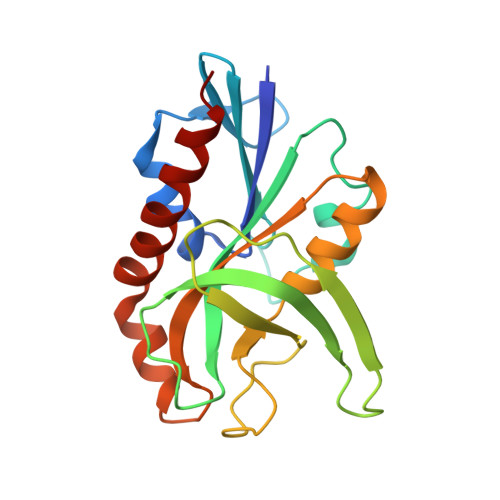Structural and Biochemical Characterization of Chlamydia trachomatis Hypothetical Protein CT263 Supports That Menaquinone Synthesis Occurs through the Futalosine Pathway.
Barta, M.L., Thomas, K., Yuan, H., Lovell, S., Battaile, K.P., Schramm, V.L., Hefty, P.S.(2014) J Biological Chem 289: 32214-32229
- PubMed: 25253688
- DOI: https://doi.org/10.1074/jbc.M114.594325
- Primary Citation of Related Structures:
4QAQ, 4QAR, 4QAS, 4QAT, 4QFB - PubMed Abstract:
The obligate intracellular human pathogen Chlamydia trachomatis is the etiological agent of blinding trachoma and sexually transmitted disease. Genomic sequencing of Chlamydia indicated this medically important bacterium was not exclusively dependent on the host cell for energy. In order for the electron transport chain to function, electron shuttling between membrane-embedded complexes requires lipid-soluble quinones (e.g. menaquionone or ubiquinone). The sources or biosynthetic pathways required to obtain these electron carriers within C. trachomatis are poorly understood. The 1.58Å crystal structure of C. trachomatis hypothetical protein CT263 presented here supports a role in quinone biosynthesis. Although CT263 lacks sequence-based functional annotation, the crystal structure of CT263 displays striking structural similarity to 5'-methylthioadenosine nucleosidase (MTAN) enzymes. Although CT263 lacks the active site-associated dimer interface found in prototypical MTANs, co-crystal structures with product (adenine) or substrate (5'-methylthioadenosine) indicate that the canonical active site residues are conserved. Enzymatic characterization of CT263 indicates that the futalosine pathway intermediate 6-amino-6-deoxyfutalosine (kcat/Km = 1.8 × 10(3) M(-1) s(-1)), but not the prototypical MTAN substrates (e.g. S-adenosylhomocysteine and 5'-methylthioadenosine), is hydrolyzed. Bioinformatic analyses of the chlamydial proteome also support the futalosine pathway toward the synthesis of menaquinone in Chlamydiaceae. This report provides the first experimental support for quinone synthesis in Chlamydia. Menaquinone synthesis provides another target for agents to combat C. trachomatis infection.
- Department of Molecular Biosciences, University of Kansas, Lawrence, Kansas 66045.
Organizational Affiliation:


















